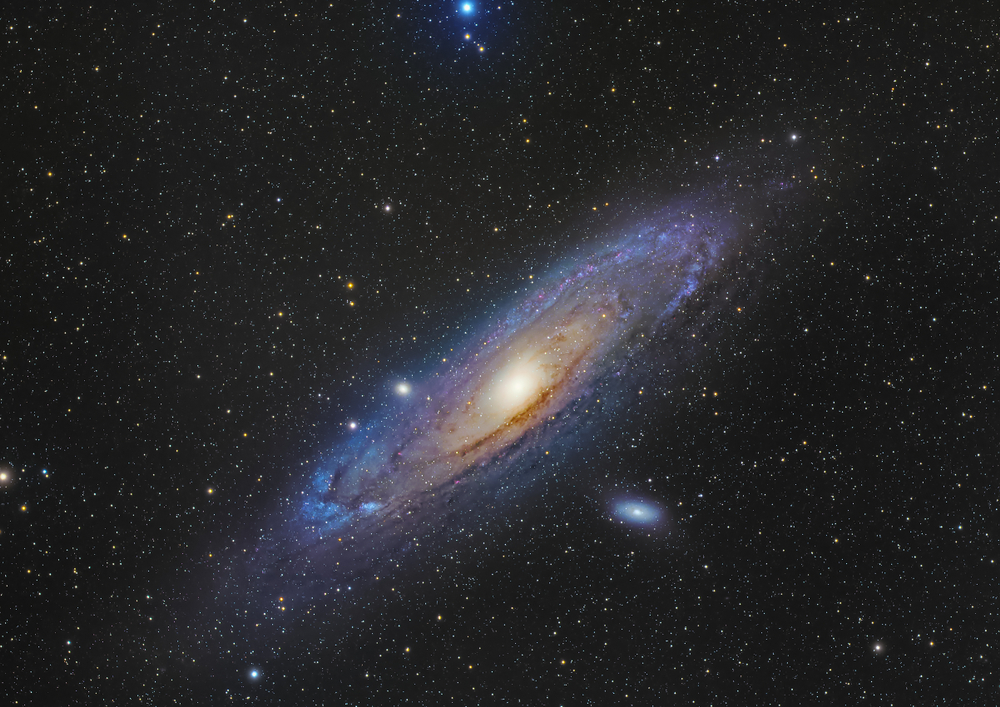The universe is vast and mysterious, with billions of galaxies scattered across it. One of the closest to our own Milky Way is the Andromeda Galaxy. Situated 2.5 million light-years from Earth, astronomers have been studying this intriguing galaxy for decades, uncovering many fascinating insights into its size, structure, and evolution.

In this article, we will embark on a journey through the Andromeda Galaxy, exploring its history, physical characteristics, and potential impact on our own galaxy.
History of Discovery & Exploration of the Andromeda Galaxy
The Andromeda Galaxy has a rich history of discovery and exploration that spans centuries. Way back in 964 AD, Persian astronomer Al-Sufi became the first person to mention the galaxy in his star catalogue, describing it as a "small cloud." However, it wasn't until the 18th century that the galaxy was identified as being separate to the Milky Way, thanks to the work of French astronomer, Charles Messier.
Messier first observed the Andromeda Galaxy on August 3, 1764, while he was searching for comets. He initially thought it was a nebula or large cloud of gas and dust, but soon realised that it was in fact a separate galaxy, just like our own Milky Way. He included the Andromeda Galaxy as the 31st entry in his famous catalogue of astronomical objects, published in 1771.
The Andromeda Galaxy continued to capture the attention of astronomers in the following centuries, with many notable scientists making important discoveries about its nature and characteristics. In 1923, American astronomer Edwin Hubble used his newly-developed telescope to identify individual stars in the Andromeda Galaxy.
Physical Characteristics: Size, Structure and Composition
Diameter: Approximately 220,000 light years
Mass: Between 700 billion and 1.5 trillion times the mass of the sun
Shape: Spiral
Number of Stars: About 1 trillion
The Andromeda Galaxy, also known as Messier 31 (after Charles Messier), is a spiral galaxy that’s approximately 220,000 light-years in diameter. It contains an estimated one trillion stars. Its structure is similar to that of our own Milky Way, with a central bulge surrounded by a flat disk of stars, gas, and dust. The Andromeda Galaxy is also orbited by two companion galaxies, Messier 32 and Messier 110. Both are satellite galaxies. In addition, the galaxy has a prominent ring of gas and dust around its centre that’s believed to have been formed by a collision with another galaxy billions of years ago. It’s also rich in heavy elements, such as carbon, nitrogen, and oxygen. These are some of the essential building blocks for the formation of planets and life as we know it.

Location and Distance: How Far Away is the Andromeda Galaxy?
The Andromeda Galaxy is located in (and takes its name from) the constellation Andromeda, which is visible from Earth’s northern hemisphere. It’s one of the brightest objects in the night sky that can be seen with the naked eye under particularly dark skies.
The Andromeda Galaxy is located approximately 2.5 million light-years away from Earth. To put that distance into perspective, one light-year is equal to about 5.88 trillion miles (9.46 trillion kilometres), so Andromeda is incredibly far away from us! Despite this distance, it’s actually the closest galaxy to our own Milky Way, belonging to a group known as the “Local Group” of galaxies.
Measuring the distance to the Andromeda Galaxy has been a significant challenge for astronomers throughout history. Early attempts relied on methods such as parallax, which involves measuring the apparent shift in position of an object as seen from two different points. However, this proved to be too difficult for such a distant object. American astronomer Edwin Hubble used Cepheid variables to estimate the distance to the Andromeda Galaxy, using the fact that the brightness of these stars is related to their period of pulsation. He found that the Andromeda Galaxy was much farther away than previously thought, helping to confirm the concept of an expanding universe!
Today, astronomers use a variety of methods to study the Andromeda Galaxy. One of the most important is redshift, which is a phenomenon that occurs when light from an object is stretched out to longer wavelengths as it travels through space. By studying the redshift of light from distant galaxies, astronomers can determine how far away they are and how fast they are moving. In fact, observations of the Andromeda Galaxy's redshift suggest that it is actually approaching our own Milky Way at a rate of about 110 kilometres per second, and the two galaxies are expected to collide in about 4.5 billion years.
Formation & Evolution of the Andromeda Galaxy
It’s believed that the Andromeda Galaxy was formed approximately 10 billion years ago, through the gravitational collapse of a large cloud of gas and dust. Over time, this material clumped together to form stars and, eventually, the spiral arms that we see today. Although the exact processes that led to the formation of the Andromeda Galaxy are still not fully understood, much research is being done to try to unravel the mysteries of galaxy formation.
As the Andromeda Galaxy evolved, it went through a number of significant changes. For example, approximately 2 billion years ago the galaxy experienced an intense period of star formation, which led to the creation of many of the stars we see in the night sky today.

Andromeda Galaxy’s Role in Understanding the Universe
The Andromeda Galaxy plays a key role in our understanding of the universe, both in terms of its own properties and its relationship to other galaxies. One particularly important aspect of studying Andromeda is its relationship to the Milky Way galaxy. Because Andromeda is the closest large galaxy to our own, it provides an important point of comparison for understanding the properties and evolution of the Milky Way.
By studying Andromeda, astronomers can also learn more about the formation and evolution of galaxies in a general sense, as well as the properties and behaviour of the stars, gas, and other components within them. All of this helps to shed light on the larger-scale structure of the universe.
Interesting Facts About the Andromeda Galaxy
- Like many galaxies, the Andromeda Galaxy is surrounded by a halo of dark matter that makes up the majority of its mass.
- In about 4.5 billion years, the Andromeda Galaxy is expected to collide with the Milky Way, potentially reshaping both galaxies.
- There's a supermassive black hole at the centre of the Andromeda galaxy. It possesses a mass of 100 million times that of the sun!
- The galaxy takes its name from Andromeda, the constellation in which it appears. Andromeda is famous for being the wife of Perseus in Greek mythology.
- In 2012, astronomers using the Hubble Space Telescope discovered a new type of star cluster in the Andromeda Galaxy. They named it "extended clusters”.
Summary
The Andromeda Galaxy is a remarkable cosmic entity that has captured the attention and imagination of astronomers and stargazers for centuries, and it remains a fascinating subject of study and observation for scientists even today.
If you’d like to learn more, our Astronomy Diploma Course and Cosmology Diploma Course are currently available for just £29 each for a limited time (reduced from £147 each).




